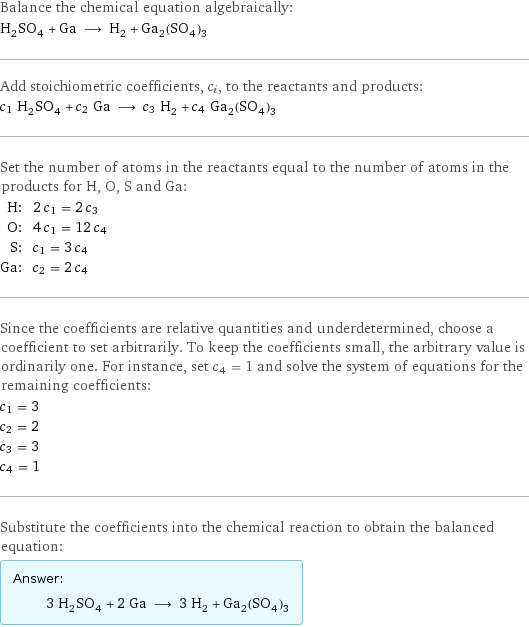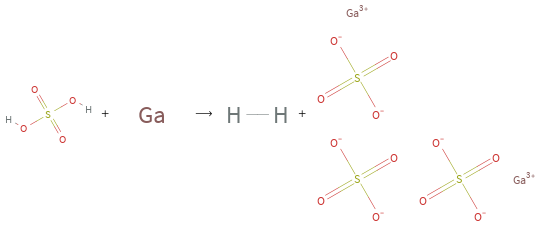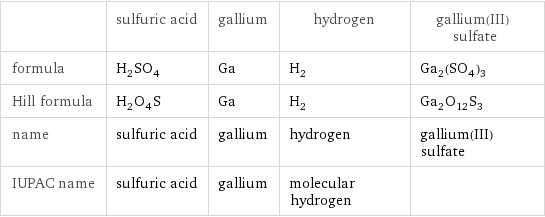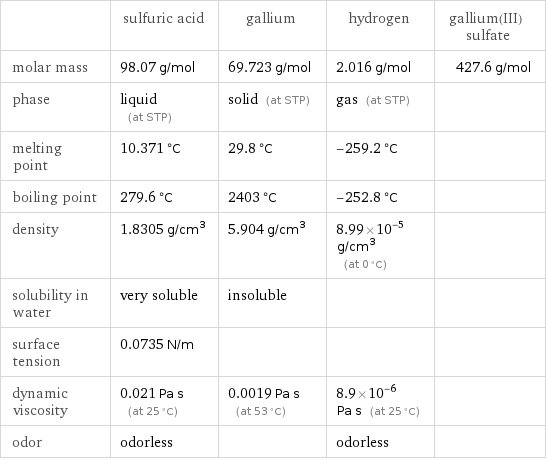Input interpretation

H_2SO_4 sulfuric acid + Ga gallium ⟶ H_2 hydrogen + Ga_2(SO_4)_3 gallium(III) sulfate
Balanced equation

Balance the chemical equation algebraically: H_2SO_4 + Ga ⟶ H_2 + Ga_2(SO_4)_3 Add stoichiometric coefficients, c_i, to the reactants and products: c_1 H_2SO_4 + c_2 Ga ⟶ c_3 H_2 + c_4 Ga_2(SO_4)_3 Set the number of atoms in the reactants equal to the number of atoms in the products for H, O, S and Ga: H: | 2 c_1 = 2 c_3 O: | 4 c_1 = 12 c_4 S: | c_1 = 3 c_4 Ga: | c_2 = 2 c_4 Since the coefficients are relative quantities and underdetermined, choose a coefficient to set arbitrarily. To keep the coefficients small, the arbitrary value is ordinarily one. For instance, set c_4 = 1 and solve the system of equations for the remaining coefficients: c_1 = 3 c_2 = 2 c_3 = 3 c_4 = 1 Substitute the coefficients into the chemical reaction to obtain the balanced equation: Answer: | | 3 H_2SO_4 + 2 Ga ⟶ 3 H_2 + Ga_2(SO_4)_3
Structures

+ ⟶ +
Names

sulfuric acid + gallium ⟶ hydrogen + gallium(III) sulfate
Equilibrium constant
![Construct the equilibrium constant, K, expression for: H_2SO_4 + Ga ⟶ H_2 + Ga_2(SO_4)_3 Plan: • Balance the chemical equation. • Determine the stoichiometric numbers. • Assemble the activity expression for each chemical species. • Use the activity expressions to build the equilibrium constant expression. Write the balanced chemical equation: 3 H_2SO_4 + 2 Ga ⟶ 3 H_2 + Ga_2(SO_4)_3 Assign stoichiometric numbers, ν_i, using the stoichiometric coefficients, c_i, from the balanced chemical equation in the following manner: ν_i = -c_i for reactants and ν_i = c_i for products: chemical species | c_i | ν_i H_2SO_4 | 3 | -3 Ga | 2 | -2 H_2 | 3 | 3 Ga_2(SO_4)_3 | 1 | 1 Assemble the activity expressions accounting for the state of matter and ν_i: chemical species | c_i | ν_i | activity expression H_2SO_4 | 3 | -3 | ([H2SO4])^(-3) Ga | 2 | -2 | ([Ga])^(-2) H_2 | 3 | 3 | ([H2])^3 Ga_2(SO_4)_3 | 1 | 1 | [Ga2(SO4)3] The equilibrium constant symbol in the concentration basis is: K_c Mulitply the activity expressions to arrive at the K_c expression: Answer: | | K_c = ([H2SO4])^(-3) ([Ga])^(-2) ([H2])^3 [Ga2(SO4)3] = (([H2])^3 [Ga2(SO4)3])/(([H2SO4])^3 ([Ga])^2)](../image_source/4b6f5a73f5f073c4fec3f84727e3c920.png)
Construct the equilibrium constant, K, expression for: H_2SO_4 + Ga ⟶ H_2 + Ga_2(SO_4)_3 Plan: • Balance the chemical equation. • Determine the stoichiometric numbers. • Assemble the activity expression for each chemical species. • Use the activity expressions to build the equilibrium constant expression. Write the balanced chemical equation: 3 H_2SO_4 + 2 Ga ⟶ 3 H_2 + Ga_2(SO_4)_3 Assign stoichiometric numbers, ν_i, using the stoichiometric coefficients, c_i, from the balanced chemical equation in the following manner: ν_i = -c_i for reactants and ν_i = c_i for products: chemical species | c_i | ν_i H_2SO_4 | 3 | -3 Ga | 2 | -2 H_2 | 3 | 3 Ga_2(SO_4)_3 | 1 | 1 Assemble the activity expressions accounting for the state of matter and ν_i: chemical species | c_i | ν_i | activity expression H_2SO_4 | 3 | -3 | ([H2SO4])^(-3) Ga | 2 | -2 | ([Ga])^(-2) H_2 | 3 | 3 | ([H2])^3 Ga_2(SO_4)_3 | 1 | 1 | [Ga2(SO4)3] The equilibrium constant symbol in the concentration basis is: K_c Mulitply the activity expressions to arrive at the K_c expression: Answer: | | K_c = ([H2SO4])^(-3) ([Ga])^(-2) ([H2])^3 [Ga2(SO4)3] = (([H2])^3 [Ga2(SO4)3])/(([H2SO4])^3 ([Ga])^2)
Rate of reaction
![Construct the rate of reaction expression for: H_2SO_4 + Ga ⟶ H_2 + Ga_2(SO_4)_3 Plan: • Balance the chemical equation. • Determine the stoichiometric numbers. • Assemble the rate term for each chemical species. • Write the rate of reaction expression. Write the balanced chemical equation: 3 H_2SO_4 + 2 Ga ⟶ 3 H_2 + Ga_2(SO_4)_3 Assign stoichiometric numbers, ν_i, using the stoichiometric coefficients, c_i, from the balanced chemical equation in the following manner: ν_i = -c_i for reactants and ν_i = c_i for products: chemical species | c_i | ν_i H_2SO_4 | 3 | -3 Ga | 2 | -2 H_2 | 3 | 3 Ga_2(SO_4)_3 | 1 | 1 The rate term for each chemical species, B_i, is 1/ν_i(Δ[B_i])/(Δt) where [B_i] is the amount concentration and t is time: chemical species | c_i | ν_i | rate term H_2SO_4 | 3 | -3 | -1/3 (Δ[H2SO4])/(Δt) Ga | 2 | -2 | -1/2 (Δ[Ga])/(Δt) H_2 | 3 | 3 | 1/3 (Δ[H2])/(Δt) Ga_2(SO_4)_3 | 1 | 1 | (Δ[Ga2(SO4)3])/(Δt) (for infinitesimal rate of change, replace Δ with d) Set the rate terms equal to each other to arrive at the rate expression: Answer: | | rate = -1/3 (Δ[H2SO4])/(Δt) = -1/2 (Δ[Ga])/(Δt) = 1/3 (Δ[H2])/(Δt) = (Δ[Ga2(SO4)3])/(Δt) (assuming constant volume and no accumulation of intermediates or side products)](../image_source/2b4e3b5a636f5ffaa70c26ff383c03c3.png)
Construct the rate of reaction expression for: H_2SO_4 + Ga ⟶ H_2 + Ga_2(SO_4)_3 Plan: • Balance the chemical equation. • Determine the stoichiometric numbers. • Assemble the rate term for each chemical species. • Write the rate of reaction expression. Write the balanced chemical equation: 3 H_2SO_4 + 2 Ga ⟶ 3 H_2 + Ga_2(SO_4)_3 Assign stoichiometric numbers, ν_i, using the stoichiometric coefficients, c_i, from the balanced chemical equation in the following manner: ν_i = -c_i for reactants and ν_i = c_i for products: chemical species | c_i | ν_i H_2SO_4 | 3 | -3 Ga | 2 | -2 H_2 | 3 | 3 Ga_2(SO_4)_3 | 1 | 1 The rate term for each chemical species, B_i, is 1/ν_i(Δ[B_i])/(Δt) where [B_i] is the amount concentration and t is time: chemical species | c_i | ν_i | rate term H_2SO_4 | 3 | -3 | -1/3 (Δ[H2SO4])/(Δt) Ga | 2 | -2 | -1/2 (Δ[Ga])/(Δt) H_2 | 3 | 3 | 1/3 (Δ[H2])/(Δt) Ga_2(SO_4)_3 | 1 | 1 | (Δ[Ga2(SO4)3])/(Δt) (for infinitesimal rate of change, replace Δ with d) Set the rate terms equal to each other to arrive at the rate expression: Answer: | | rate = -1/3 (Δ[H2SO4])/(Δt) = -1/2 (Δ[Ga])/(Δt) = 1/3 (Δ[H2])/(Δt) = (Δ[Ga2(SO4)3])/(Δt) (assuming constant volume and no accumulation of intermediates or side products)
Chemical names and formulas

| sulfuric acid | gallium | hydrogen | gallium(III) sulfate formula | H_2SO_4 | Ga | H_2 | Ga_2(SO_4)_3 Hill formula | H_2O_4S | Ga | H_2 | Ga_2O_12S_3 name | sulfuric acid | gallium | hydrogen | gallium(III) sulfate IUPAC name | sulfuric acid | gallium | molecular hydrogen |
Substance properties

| sulfuric acid | gallium | hydrogen | gallium(III) sulfate molar mass | 98.07 g/mol | 69.723 g/mol | 2.016 g/mol | 427.6 g/mol phase | liquid (at STP) | solid (at STP) | gas (at STP) | melting point | 10.371 °C | 29.8 °C | -259.2 °C | boiling point | 279.6 °C | 2403 °C | -252.8 °C | density | 1.8305 g/cm^3 | 5.904 g/cm^3 | 8.99×10^-5 g/cm^3 (at 0 °C) | solubility in water | very soluble | insoluble | | surface tension | 0.0735 N/m | | | dynamic viscosity | 0.021 Pa s (at 25 °C) | 0.0019 Pa s (at 53 °C) | 8.9×10^-6 Pa s (at 25 °C) | odor | odorless | | odorless |
Units
